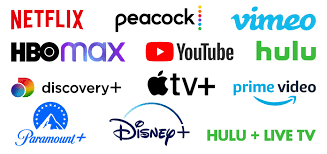Table of Contents
Toggle1. Global Dominance and Market Size
The global video streaming market, valued in the billions, has been a powerhouse of digital entertainment, captivating millions of viewers worldwide. With major players like Netflix, Amazon Prime Video, Hulu, and Disney+ leading the charge, the market has witnessed significant growth over the years.
2. User Base and Subscription Models
Streaming platforms boast massive user bases, with millions or even billions of subscribers. The shift towards subscription-based models has been a driving force behind the industry’s revenue, with users opting for monthly or annual plans to access a vast array of content.
3. Original Content Wars
One of the defining characteristics of the industry has been the intense competition among streaming services. To stay ahead in the race, platforms invested heavily in producing original content. This strategy not only set them apart but also attracted subscribers seeking exclusive and unique programming.
4. Cord-Cutting Phenomenon
Traditional cable and satellite TV subscriptions have seen a decline, giving rise to the “cord-cutting” trend. More viewers are embracing streaming services as their primary source of entertainment, contributing to the changing landscape of how we consume content.
5. Mobile Streaming and Multiscreen Viewing
The surge in mobile device usage has transformed streaming habits. Viewers now consume content on smartphones and tablets, often engaging in multiscreen viewing by simultaneously using multiple devices.
6. Pandemic-Driven Surge
The COVID-19 pandemic in 2020 led to a significant surge in streaming, with people worldwide seeking entertainment at home during lockdowns. This period accelerated the adoption of streaming services and emphasized their importance in our daily lives.
7. Technological Advancements: AI and 4K Streaming
Technological advancements have played a crucial role in the industry’s evolution. Artificial intelligence and machine learning are now integral to content recommendations, providing personalized viewing experiences. Furthermore, the rise of high-definition and 4K streaming has reshaped user expectations for quality.
8. Global Expansion and Regional Content
Streaming platforms expanded their reach globally, offering content tailored to regional preferences. This strategy not only broadened their audience base but also diversified the types of content available.
9. Challenges: Piracy and Regulatory Hurdles
The industry has faced challenges such as content piracy and regulatory hurdles. The battle against illegal streaming services and the need to navigate varying regulations in different regions have been ongoing concerns.
10. Future Trends: VR, AR, and Interactive Content
Looking ahead, the industry is exploring virtual reality (VR) and augmented reality (AR) content to provide immersive experiences. Additionally, the rise of interactive content, where viewers can shape the storyline, is an exciting frontier for the future.
As the video streaming industry continues to evolve, these key statistics and trends shape the narrative of digital entertainment. From the battle for exclusive content to the global shift in viewing habits, the streaming landscape is a fascinating arena where innovation and user preferences collide.
Please note that these insights are based on information available up to January 2024. For the latest developments, stay tuned to industry reports, news updates, and official announcements from your favorite streaming platforms. The journey of video streaming is a captivating one, and we can only anticipate more exciting developments on the horizon.
11. Live Streaming and Event Coverage
Live streaming has become a prominent feature, providing real-time access to events, including sports, concerts, gaming tournaments, and news. Viewers now hcantune in and engage with live content, fostering a sense of immediacy and community.
12. Partnerships and Acquisitions
In the quest to enhance their content libraries and technological capabilities, streaming platforms have engaged in strategic partnerships and acquisitions. These collaborations aim to secure exclusive rights, broaden content offerings, and stay ahead of the competition.
13. Ad-Supported Models and Dynamic Pricing
While subscription-based models dominate, some platforms have embraced ad-supported models. These models offer free access to content, with revenue generated through strategically placed advertisements. Additionally, dynamic pricing models have emerged, providing users with different subscription tiers, each offering varying features and price points.
14. Offline Viewing and Download Options
Recognizing the diverse needs of users, many streaming services introduced offline viewing options. This feature allows subscribers to download content for later consumption without needing a stable internet connection, catering to those on the go.
15. Quality of Service Standards
With the proliferation of high-definition and 4K streaming, maintaining a high-quality viewing experience has become paramount. Industry standards for streaming quality have been established, emphasizing consistent playback, low latency, and minimal buffering for users.
16. Educational and Niche Content
Streaming platforms are increasingly catering to niche audiences by offering specialized content. Educational content, in particular, has gained traction, providing viewers with opportunities to learn and explore various subjects through digital platforms.
17. Environmental Impact and Sustainability
The energy consumption of data centers and the overall environmental impact of streaming services have become topics of discussion. Some industry players are actively exploring ways to minimize their carbon footprint and implement more sustainable practices.
18. Device Compatibility and Accessibility
Streaming services are designed to be accessible across a wide range of devices, including smart TVs, gaming consoles, smartphones, and tablets. This flexibility ensures that users can enjoy their favorite content on the device of their choice.
19. Viewer Demographics and Personalization
The diverse demographic engaging with streaming services spans various age groups and interests. Advanced artificial intelligence and machine learning algorithms are employed to analyze user preferences, providing personalized content recommendations and enhancing the overall viewing experience.
20. Global Events and Industry Resilience
Global events, such as the COVID-19 pandemic, showcased the resilience of the streaming industry. As people sought solace and entertainment during challenging times, streaming services became a reliable source of comfort, contributing to their sustained growth.
As we venture further into the future, the video streaming industry will undoubtedly continue to surprise us with innovations, trends, and disruptions. Stay tuned for more exciting developments as this digital revolution unfolds. For the latest updates, keep an eye on industry reports, news articles, and official communications from your favourite streaming platforms. Happy streaming!
21. Community Engagement and Social Features
Streaming platforms are increasingly incorporating social features to enhance user engagement. Interactive elements such as live chat during broadcasts, community forums, and shared watchlists are fostering a sense of community among viewers.
22. Short-form content and Bite-sized Entertainment
The rise of short-form content has become a notable trend. Platforms are offering bite-sized entertainment in the form of web series, mini-episodes, and quick, easily consumable content to cater to users with shorter attention spans.
23. Virtual and Augmented Reality Experiences
The exploration of virtual reality (VR) and augmented reality (AR) is gaining momentum. Some streaming services are experimenting with immersive experiences, allowing users to step into virtual worlds or interact with content in augmented reality environments.
24. Data Consumption and Network Optimization
The popularity of streaming has contributed to increased data consumption globally. To address this, streaming services and internet service providers (ISPs) are collaborating on network optimization strategies to ensure smoother streaming experiences without overwhelming network infrastructures.
25. Privacy Concerns and Data Security
As streaming platforms gather vast amounts of user data to personalize recommendations, privacy concerns have arisen. Platforms are increasingly focusing on data security measures and transparent privacy policies to reassure users about the protection of their personal information.
26. Platform Differentiation Strategies
To stand out in the crowded streaming market, platforms are adopting unique differentiation strategies. Some focus on specific genres or target niche audiences, while others invest heavily in technological advancements, exclusive partnerships, or cutting-edge features.
27. User Metrics and Analytics for Content Optimization
The analysis of user metrics has become pivotal for streaming services. Platforms closely monitor watch time, user retention rates, and content ratings to understand viewer behaviour, optimize their content libraries, and tailor their services to user preferences.
28. Global Partnerships with ISPs and Content Providers
Collaborations between streaming services, internet service providers (ISPs), and content providers are becoming more common. These partnerships aim to enhance streaming performance, reduce buffering, and expand content offerings through bundled services.
29. Global Events Impact: Political and Economic Factors
Apart from the COVID-19 pandemic, political and economic factors on a global scale can impact the streaming industry. Changes in regulations, economic downturns, or geopolitical events may influence the availability and accessibility of streaming services in different regions.
30. Podcasting and Audio Content Integration
Some streaming platforms are diversifying their content offerings by integrating podcasts and audio content. This trend acknowledges the growing popularity of audio-based entertainment and provides users with a more comprehensive digital media experience.
As the video streaming industry continues to evolve, it intertwines with technological advancements, societal shifts, and changing user expectations. These trends reflect the industry’s commitment to innovation and adaptation, ensuring that viewers can always find something tailored to their preferences in this vast and ever-expanding digital universe. Stay tuned for the next wave of developments in the world of video streaming!

